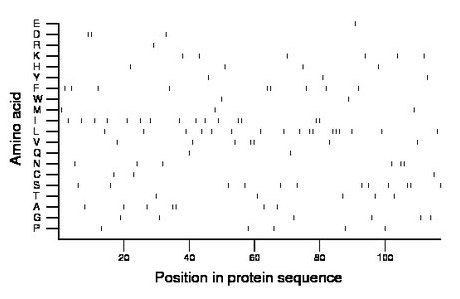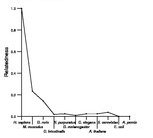
| Name: XKRY | Sequence: fasta or formatted (117aa) | NCBI GI: 50363369 | |
|
Description: XK, Kell blood group complex subunit-related, Y-linked
|
Referenced in: Hematopoiesis and Erythrocytes
| ||
|
Composition:

Amino acid Percentage Count Longest homopolymer A alanine 6.0 7 2 C cysteine 2.6 3 1 D aspartate 2.6 3 2 E glutamate 0.9 1 1 F phenylalanine 7.7 9 2 G glycine 5.1 6 1 H histidine 3.4 4 1 I isoleucine 12.8 15 2 K lysine 5.1 6 1 L leucine 14.5 17 3 M methionine 2.6 3 1 N asparagine 5.1 6 2 P proline 4.3 5 1 Q glutamine 1.7 2 1 R arginine 0.9 1 1 S serine 10.3 12 2 T threonine 4.3 5 1 V valine 6.0 7 2 W tryptophan 1.7 2 1 Y tyrosine 2.6 3 1 |
Comparative genomics:
Search single species RefSeq proteins at NCBI
Search summary 
Figure data | ||
Related human proteins:Protein Relative score Description Self-match 1.000 XK, Kell blood group complex subunit-related, Y-link... XKRY2 1.000 XK, Kell blood group complex subunit-related, Y-link... XKR3 0.412 X Kell blood group precursor-related family, member... LOC100289232 0.408 PREDICTED: hypothetical protein XP_002343935 XKRX 0.232 XK, Kell blood group complex subunit-related, X-lin... XK 0.180 membrane transport protein XK ATP9A 0.014 ATPase, class II, type 9A SYPL1 0.009 synaptophysin-like 1 isoform b SYPL1 0.009 synaptophysin-like 1 isoform a LOC100130472 0.005 PREDICTED: hypothetical protein C6orf70 0.005 hypothetical protein LOC55780 OR10A4 0.005 olfactory receptor, family 10, subfamily A, member 4... XKR8 0.005 XK, Kell blood group complex subunit-related family,... TEX261 0.005 testis expressed sequence 261Human BLASTP results (used to prepare the table) | |||
Gene descriptions are from NCBI RefSeq. Search results were obtained with NCBI BLAST and RefSeq entries. When identical proteins are present, the self-match may not be listed first in BLASTP output. In such cases, the table above has been reordered to place it first.
See About the Figures for the scoring system used in the figure above right. The same scoring system was used in the table of BLASTP results.
Guide to the Human Genome
Copyright © 2010 by Stewart Scherer. All rights reserved.
